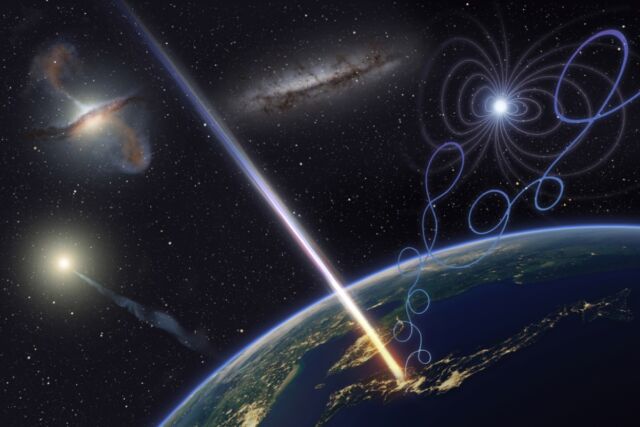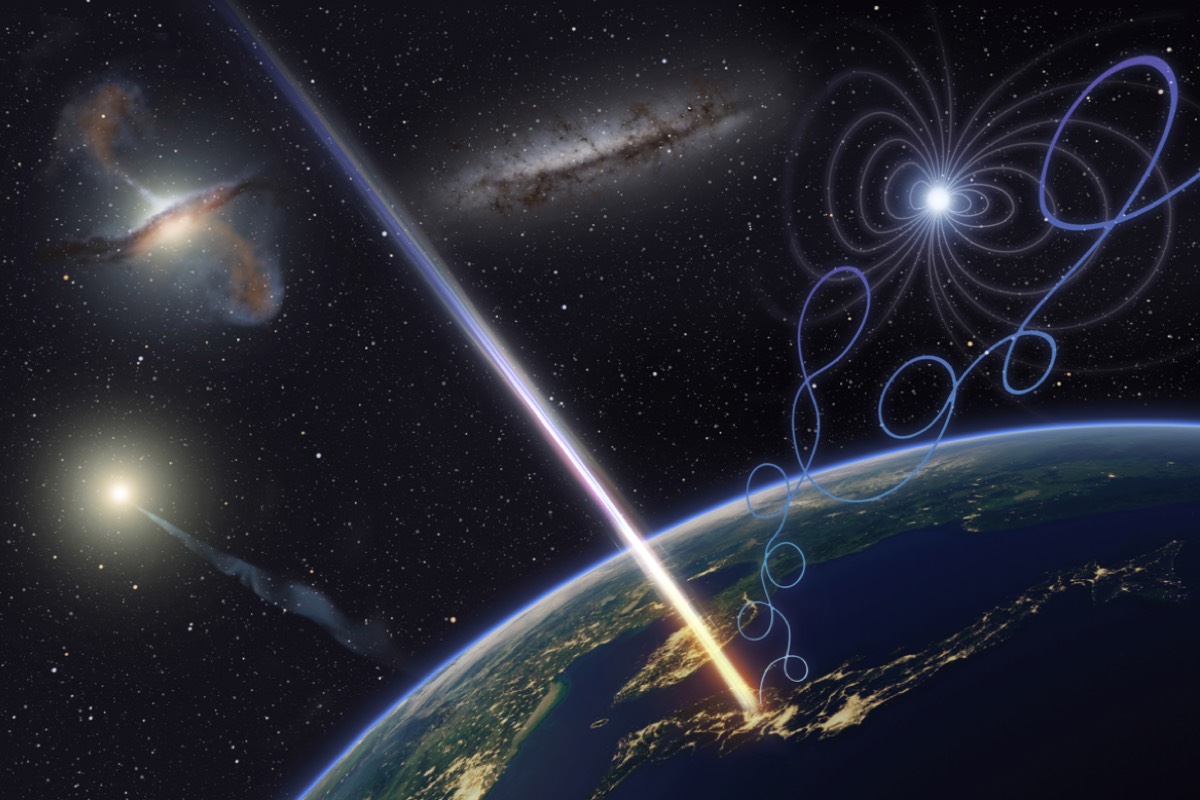Astronomers involved with the Telescope Array experiment in Utah's West Desert have detected an ultra-high-energy cosmic ray (UHECR) with a whpping energy level of 244 EeV, according to a new paper published in the journal Science. It's the most energetic cosmic ray detected since 1991, when astronomers detected the so-called "Oh-My-God' particle, with energies of an even more impressive 320 EeV. Astronomers have dubbed this latest event the "Amaterasu" particle, after the Shinto sun goddess said to have created Japan. One might even call it the "Oh-My-Goddess" particle.
Cosmic rays are highly energetic subatomic particles traveling through space near the speed of light. Technically, a cosmic ray is just an atomic nucleus made up of a proton or a cluster of protons and neutrons. Most originate from the Sun, but others come from objects outside our solar system. When these rays strike the Earth’s atmosphere, they break apart into showers of other particles (both positively and negatively charged).
They were first discovered in 1912 by Austrian physicist Victor Hess via a series of ascents in a hydrogen balloon to take measurements of radiation in the atmosphere with an electroscope. He found that the rate of ionization was a good three times the rate at sea level, thereby disproving a competing theory that this radiation came from the rocks of Earth. If you've ever seen a cloud chamber in a science museum, cosmic ray tracks look like wispy little white lines, similar to tiny jet contrails.
Cosmic rays come in a broad range of energies, with the least energetic being the most common. Those were the cosmic rays Hess detected, and are the ones most likely to show up in a museum cloud chamber. There is a theoretical limit, proposed in 1965, to just how energetic a cosmic ray should be: no more than 50 EeV coming from more than 300 million light years from Earth. That's because of the cosmic microwave background radiation, the afterglow of the Big Bang that pervades the universe, discovered in 1964. Any cosmic rays traveling further than that would be destroyed via interactions with the CMB before they reached Earth's detectors. It's known as the GZK cutoff after the scientists who proposed it (Kenneth Greisin, Georgiy Zatsepin, and Vadim Kuzmin).

The 1991 discovery of the "Oh-My-God" particle challenged that prevailing theory, hitting the Earth's atmosphere at very near the speed of light and apparently traveling from the direction of the Perseus constellation in the northern hemisphere. It carried the energy equivalent of a bowling ball dropped from shoulder height, packed tightly into a subatomic particle. Astronomers haven't seen its equal since, although they have detected dozens of events that qualify as UHECRs over the ensuing decades.
But what could be the source of such UHECRs, capable of accelerating the subatomic particles to such impressive speeds? Even a supernova wouldn't be able to do this. One possible source is an expanding shock wave from a cosmic-scale explosion—say, a black hole ripping apart a star and producing a massive jet of plasma—in which particles traverse magnetic fields over and over and pick up energy as they travel through space. Another candidate is active galactic nuclei (AGNs) typically found at the center of galaxies and assumed to contain a supermassive black hole. AGNs produce powerful jets of superheated plasma accompanied by shock waves.
Other suggestions include gamma ray bursts (themselves arising from an unknown source) or intense regions of star formation known as starburst galaxies. It doesn't help that the trajectories of UHECRs are bent by magnetic fields en route to our detectors on Earth, making it difficult to reconstruct the route they traveled and thereby pinpoint an origin point in the sky. Astronomers thought they had identified a couple of intriguing hot spots back in 2017, one in Centaurus A and the other in a galaxy called M82 in the Ursa Major constellation. But confidence in the former hotspot has weakened since 2019 as the number of UHCERs detected from there appears to be dropping.
The recorded signal and event animation of the extremely energetic particle, dubbed the "Amaterasu" particle. Credit: Osaka Metropolitan University/CC BY-SA
The Telescope Array consists of over 500 surface detectors arranged in a square grid that covers some 270 square miles (700 square kilometers) just outside of Delta, Utah. It has picked up more than 30 UHECRs since it began operation. Even so, co-author Toshihiro Fujii of Osaka Metropolitan University in Japan "thought there must have been a mistake" when the experiment picked up the "Amaterasu" particle on May 27, 2021. Extraordinary claims require extraordinary evidence, as the mantra goes, so the detection and trajectory analysis weren't announced until a conference last fall, with the paper only now just coming in Science.
Like its 1991 predecessor, astronomers are baffled as to where the particle came from. Tracing its trajectory led them to an empty area of space known as the "Local Void" bordering our Milky Way galaxy. “The particles are so high energy, they shouldn’t be affected by galactic and extra-galactic magnetic fields. You should be able to point to where they come from in the sky,” said co-author John Matthews, Telescope Array co-spokesperson at the University of Utah. “But in the case of the Oh-My-God particle and this new particle, you trace its trajectory to its source and there’s nothing high energy enough to have produced it. That’s the mystery of this—what the heck is going on?”
We might learn more once astronomers finish expanding the Telescope Array, adding 500 new scintillator detectors which would expand the detection area to 1,100 square miles (2,900 square kilometers). That should increase how often they detect such UHECRs.
“These events seem like they're coming from completely different places in the sky. It’s not like there's one mysterious source,” said co-author John Belz, also with the University of Utah. “It could be defects in the structure of spacetime, colliding cosmic strings. I mean, I’m just spit-balling crazy ideas that people are coming up with because there's not a conventional explanation. Maybe magnetic fields are stronger than we thought, but that disagrees with other observations that show they’re not strong enough to produce significant curvature at these ten-to-the-twentieth electron volt energies. It’s a real mystery.”
DOI: Science, 2023. 10.1126/science.abo5095 (About DOIs).
Listing image by Osaka Metropolitan University/L-INSIGHT, Kyoto University/Ryuunosuke Takeshige



3175x175(CURRENT).thumb.jpg.b05acc060982b36f5891ba728e6d953c.jpg)
Recommended Comments
There are no comments to display.
Join the conversation
You can post now and register later. If you have an account, sign in now to post with your account.
Note: Your post will require moderator approval before it will be visible.